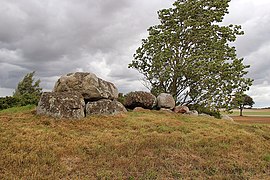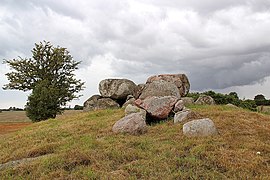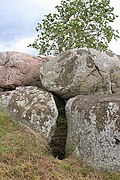Stora Kungsdlocken
The Stora Kungsdösen ( German "Großer Königsdolmen" ) is one of three double- aisle graves ( Swedish Dubbelgånggrifter ) in Sweden and in Skåne . The funnel beaker culture (TBK) facility is located near the south coast northwest of Smygehamn at Östra Torp, about two kilometers away, and was built between 3500 and 2800 BC. The passage grave is a type of Neolithic megalithic system , which consists of a chamber and a structurally separated, lateral passage. This form is primarily found in Denmark, Germany and Scandinavia, as well as occasionally in France and the Netherlands. Neolithic monuments are an expression of the culture and ideology of Neolithic societies. Their origin and function are considered to be the hallmarks of social development.
description
The smaller western chamber is almost circular and about two meters in diameter. The corridor is about three meters long. Three of the bearing stones are connected to the eastern chamber. It is rectangular, measures around 1.4 × 5.0 m and has an approximately 2.0 m long corridor.
The facility was examined in 1851 and 1915. Various objects made of stone and flint and shards of ceramic vessels were found.
Stora Kungsdösen is, although the name means something else (Swedish: Döse = dolmen), not a dolmen, but like Snarringe and the Stenhögen on Karabyvägen near Kävlinge one of the few passage graves in Sweden that are located in long hills. The main distribution area of this special system form is in Denmark, where there are 57 double-passage graves (Danish Dobbeltjættestuer or Tvillingejættestuer), but mostly in round hills.
About 150 m to the east is "Lilla Kungsdösen" (Eng. Small King Dolmen), another passage grave. The chamber measures 5.0 × 2.5 m and the corridor is 2.5 m long. Erkes dös is also nearby.
Erkes doze
Although the complex is called "Erkes dös" (dös = dolmen ), it is a small passage grave. The approximately 3 × 4 m large chamber is covered by two large blocks. A 5 m long corridor leads into the chamber from the east side. About 30 bowls are picked on one of the stones . Erkes dös, were examined in 1915. Amber beads, pottery shards and flint objects were found inside and outside the chamber.
- Erkes doze
Legend has it that there was a path through the fields to the Großer Kungsdösen that was trodden on by trolls visiting each other.
See also
literature
- Karsten Kjer Michaelsen: Politics bog om Danmarks oldtid. Politiken, Copenhagen 2002, ISBN 87-567-6458-8 , p. 253 ( Politikens håndbøger ).
Individual evidence
- ↑ J. Müller In: Varia neolithica VI 2009 p. 15
- ↑ This is due to the Swedish nomenclature, in which only systems with long corridors are referred to as passage graves. This is unfavorable in that corridors are also the easiest components to remove.
Web links
Coordinates: 55 ° 21 ′ 5 ″ N , 13 ° 20 ′ 33 ″ E





